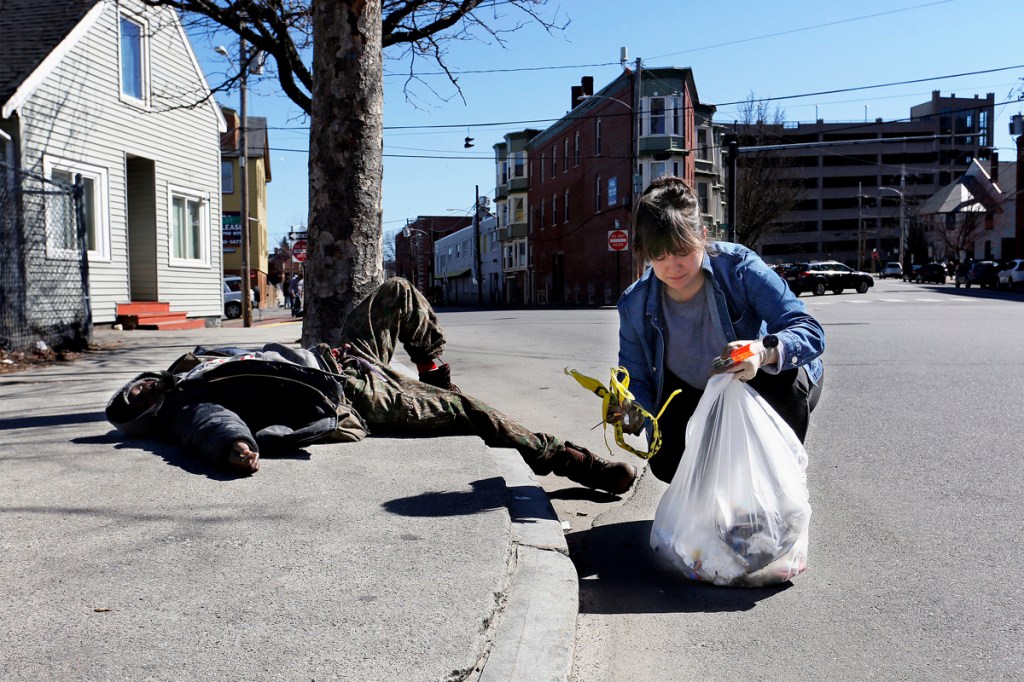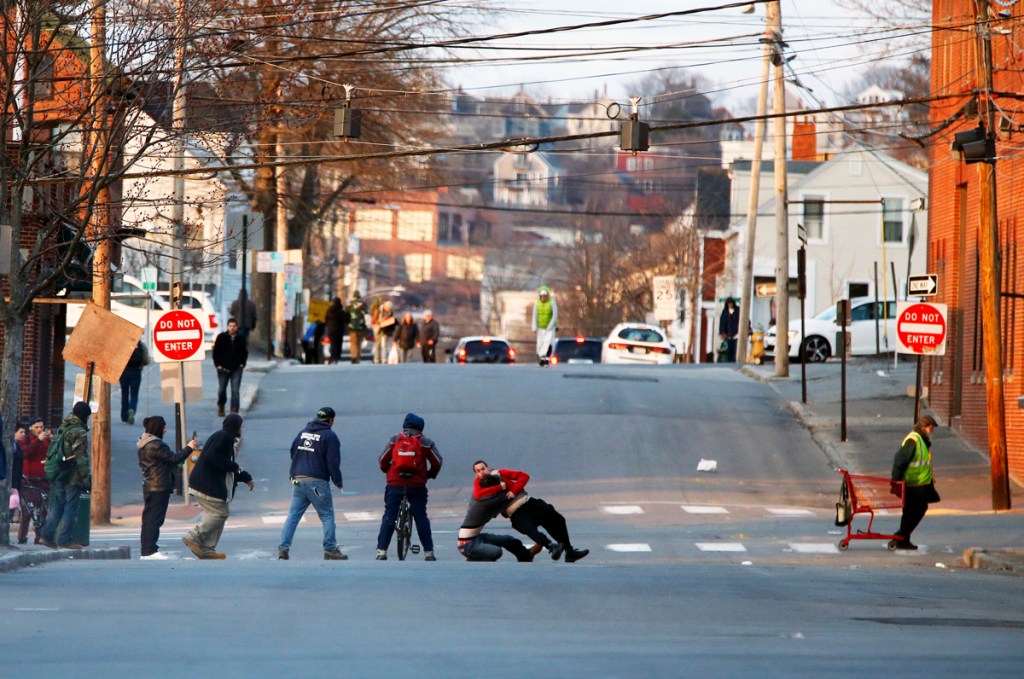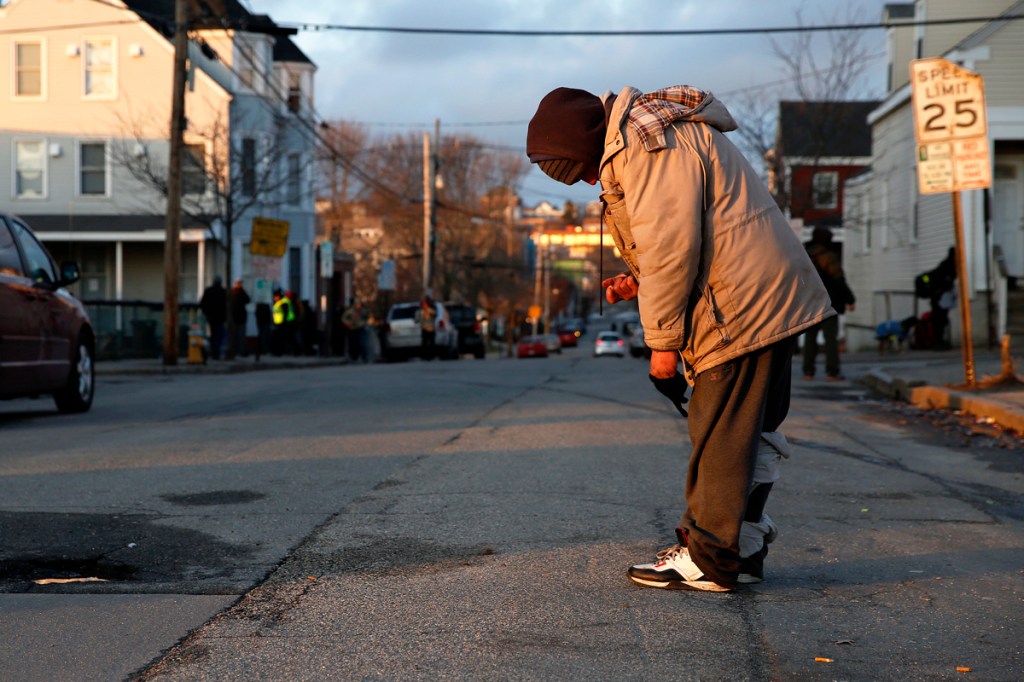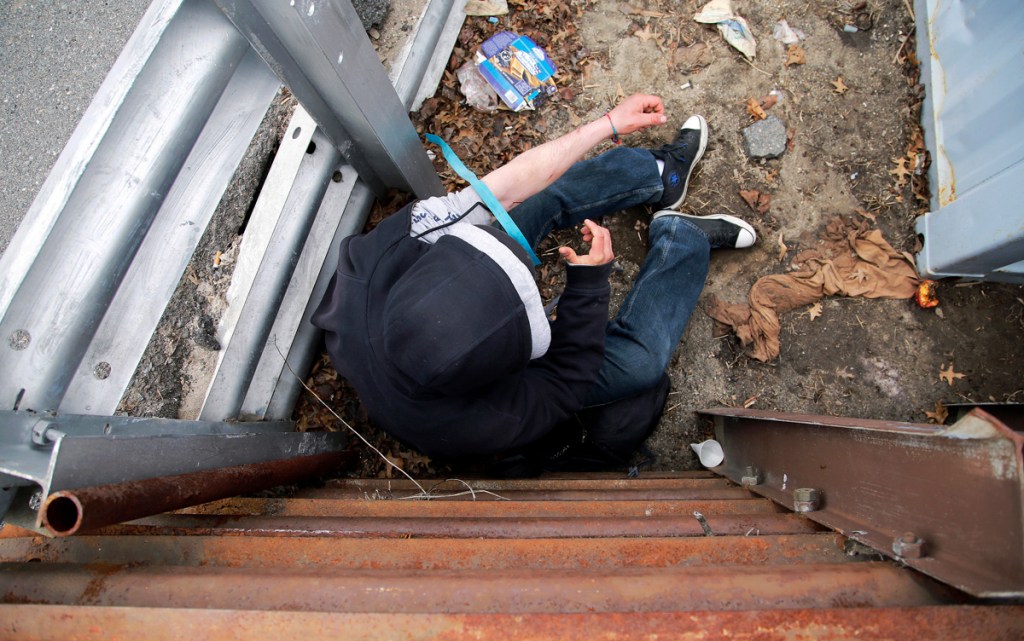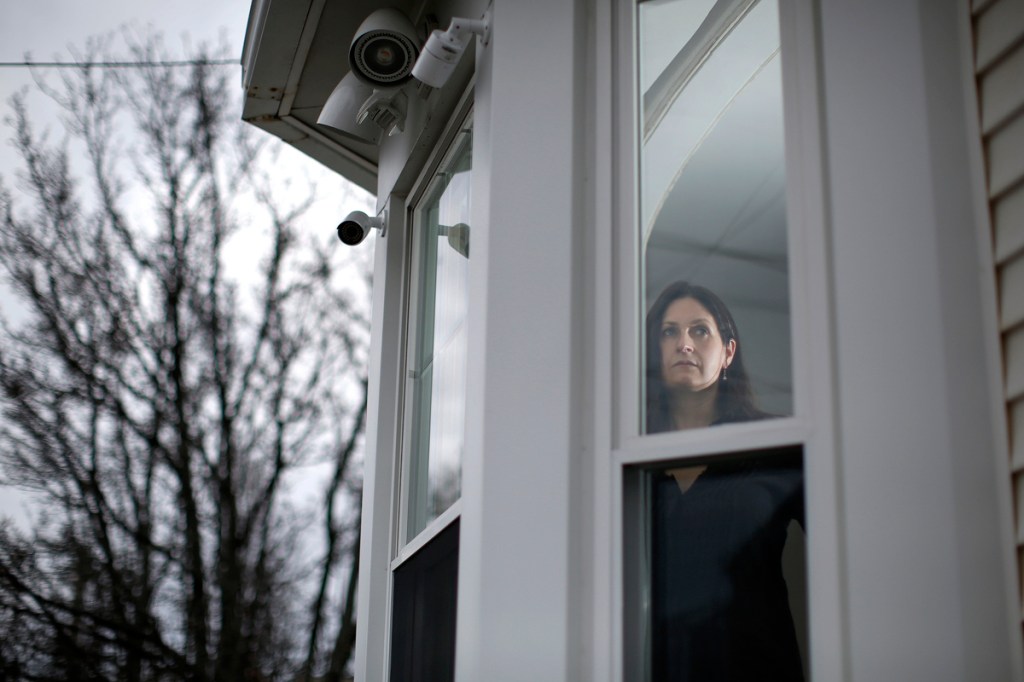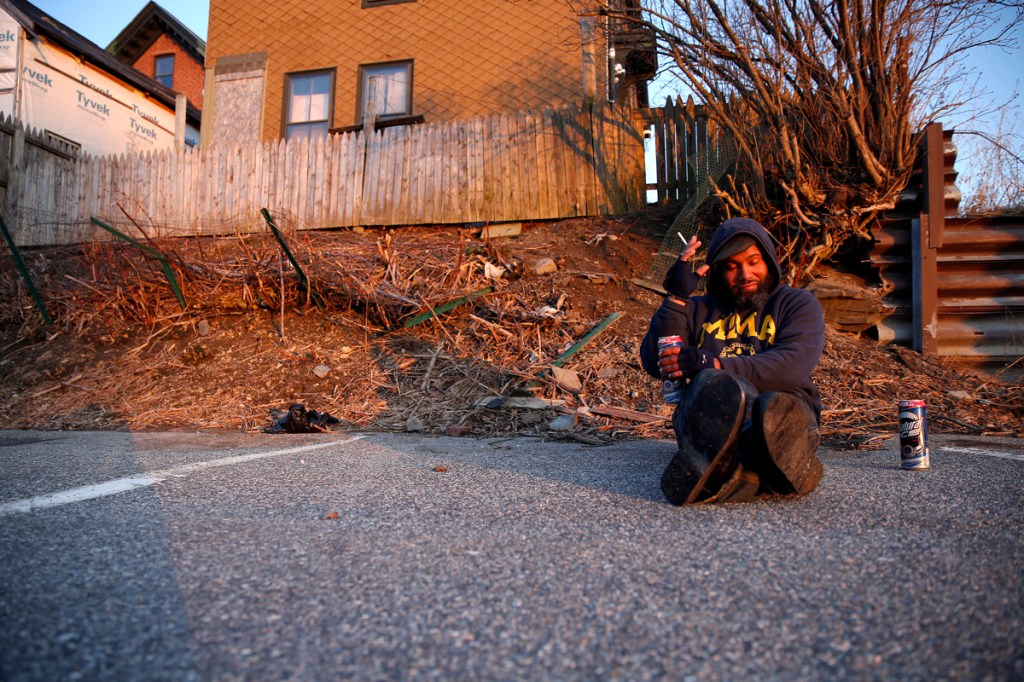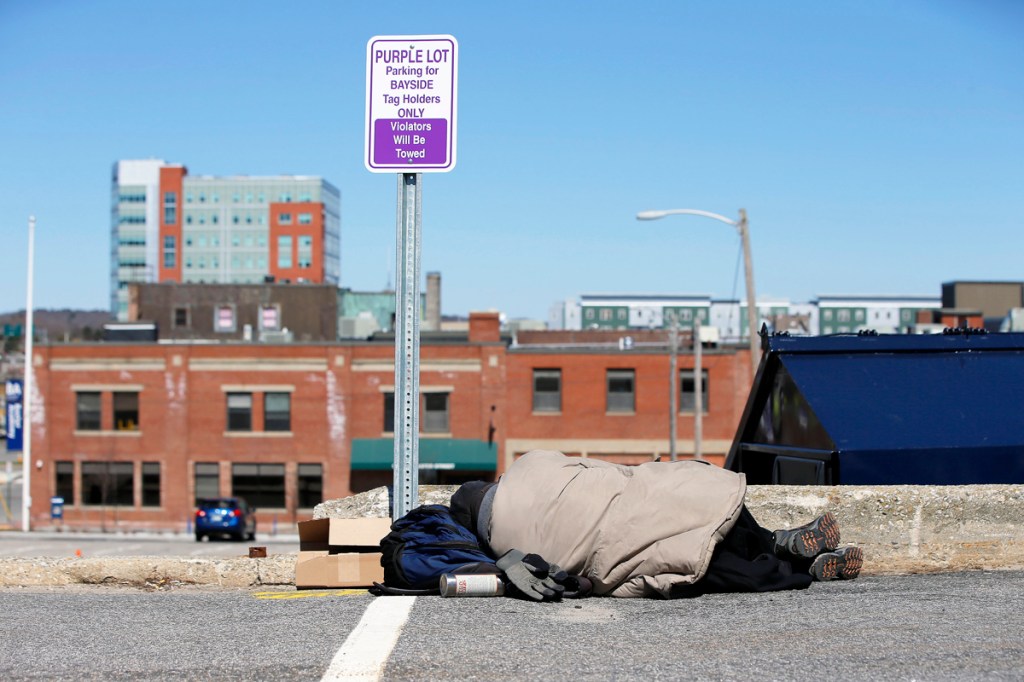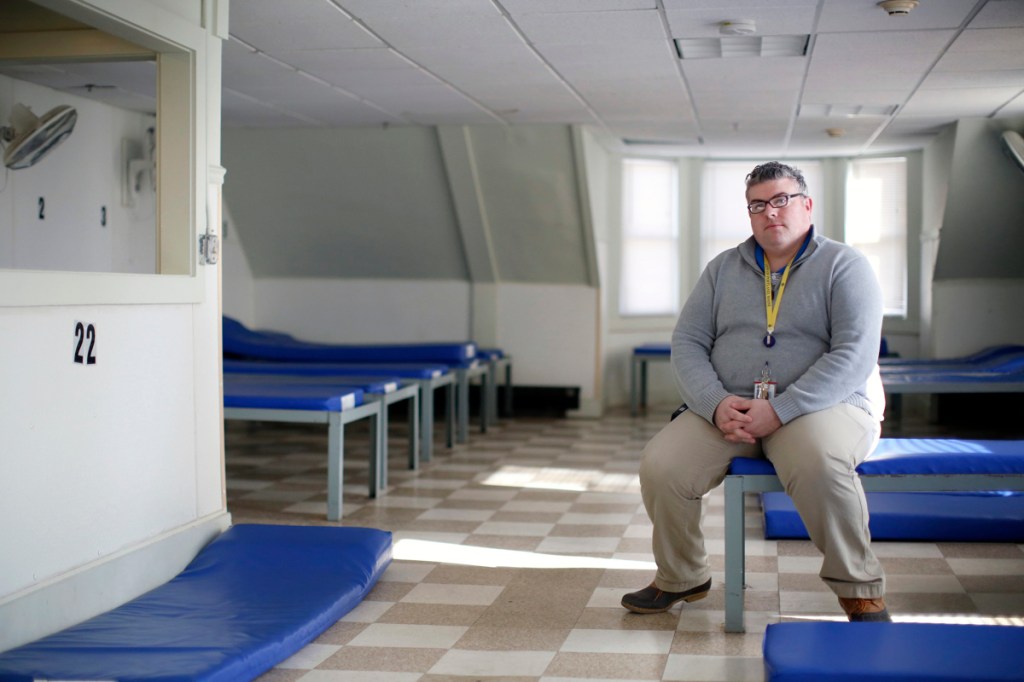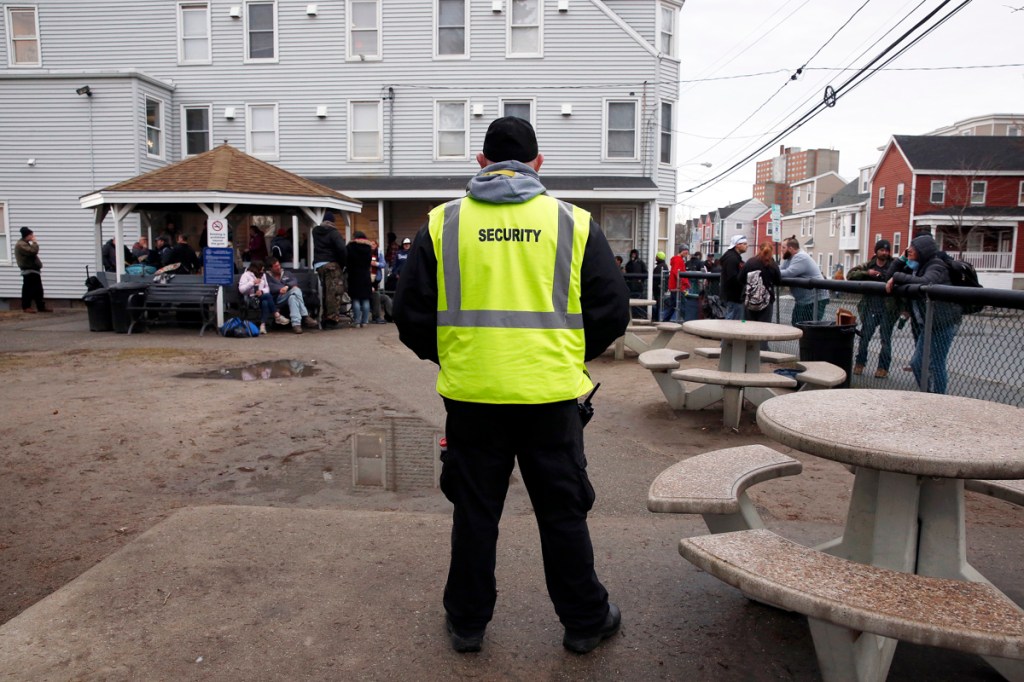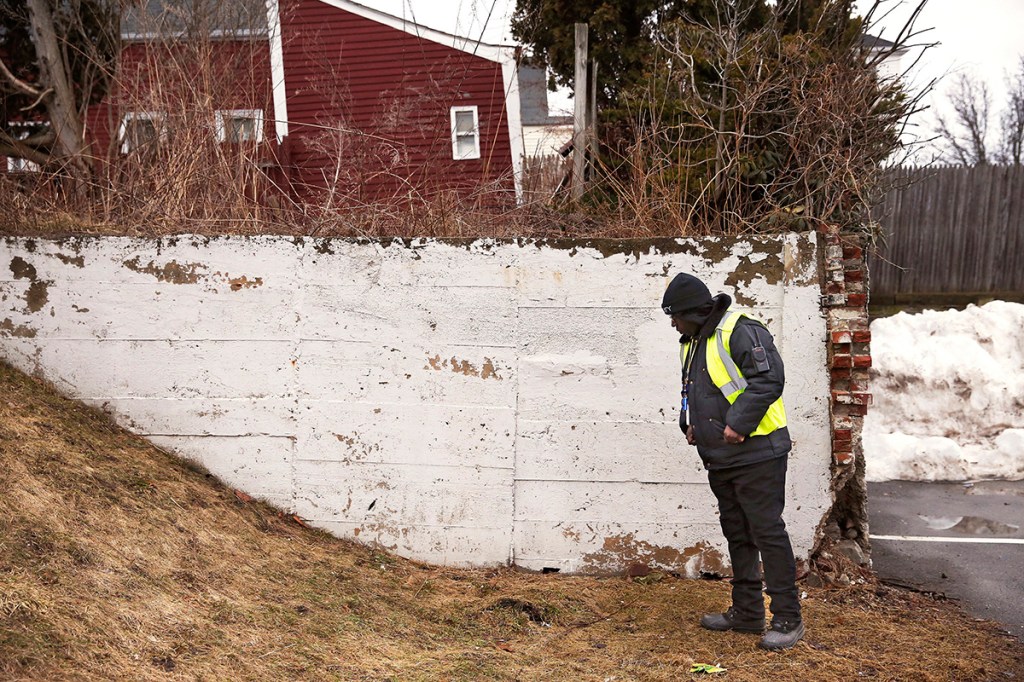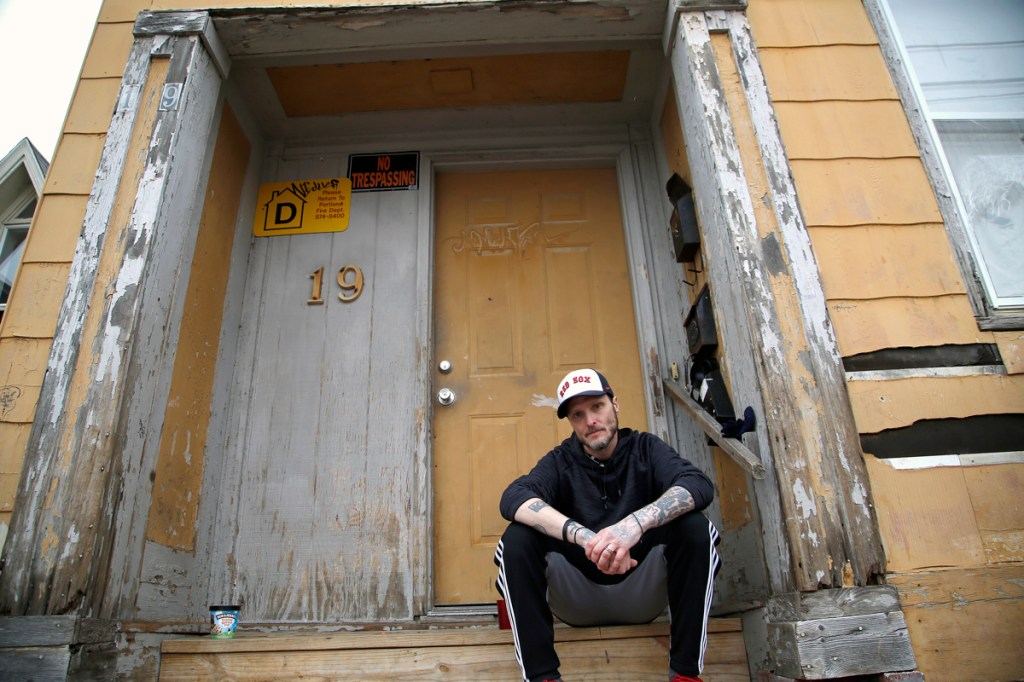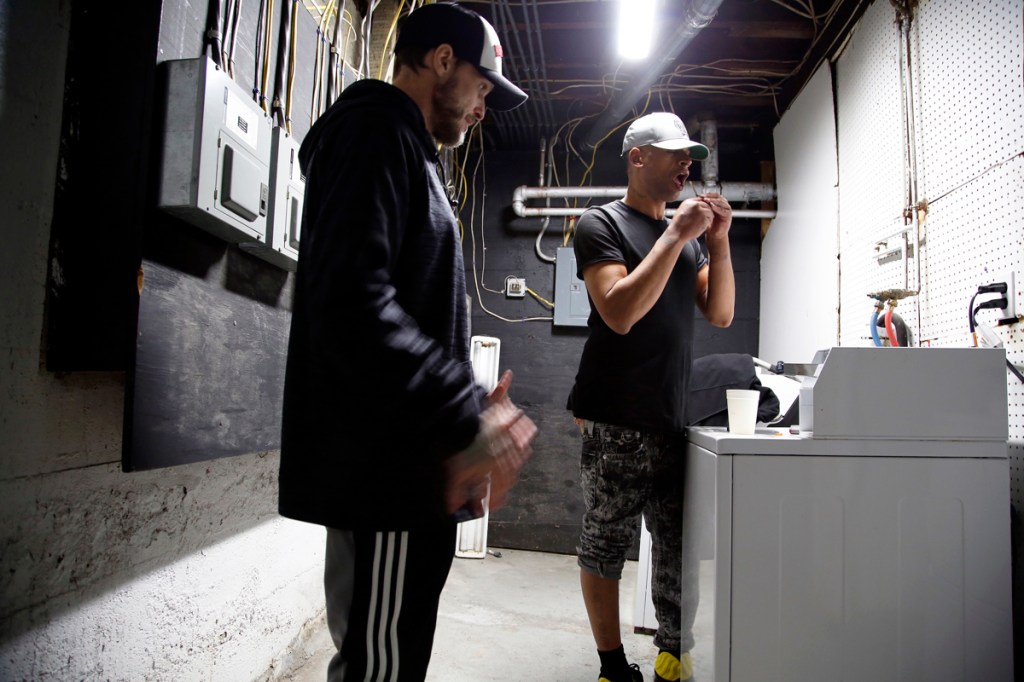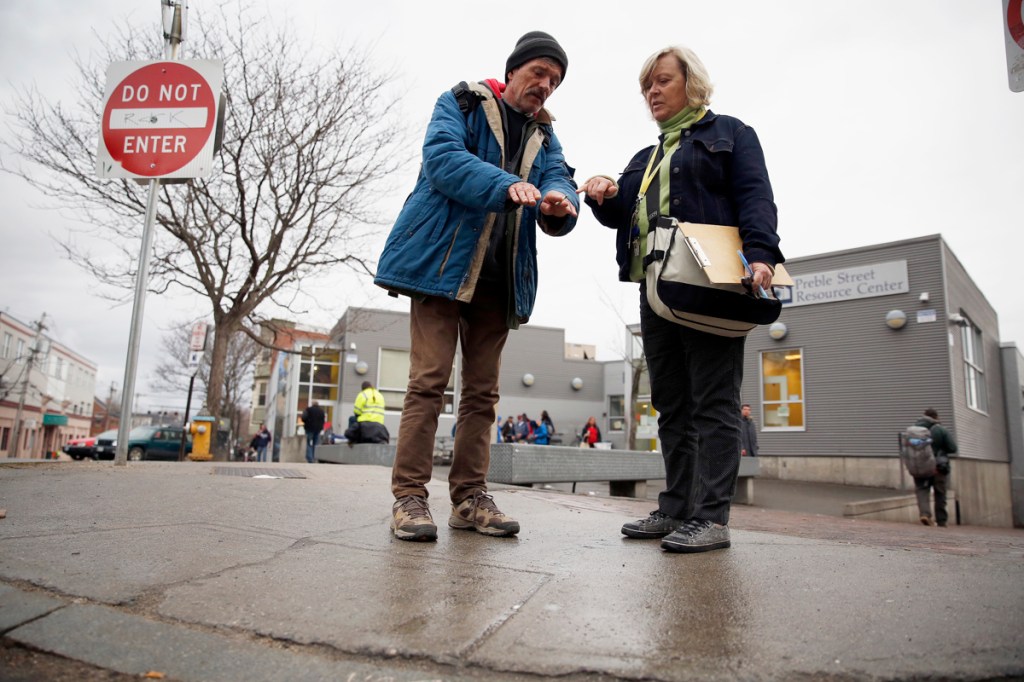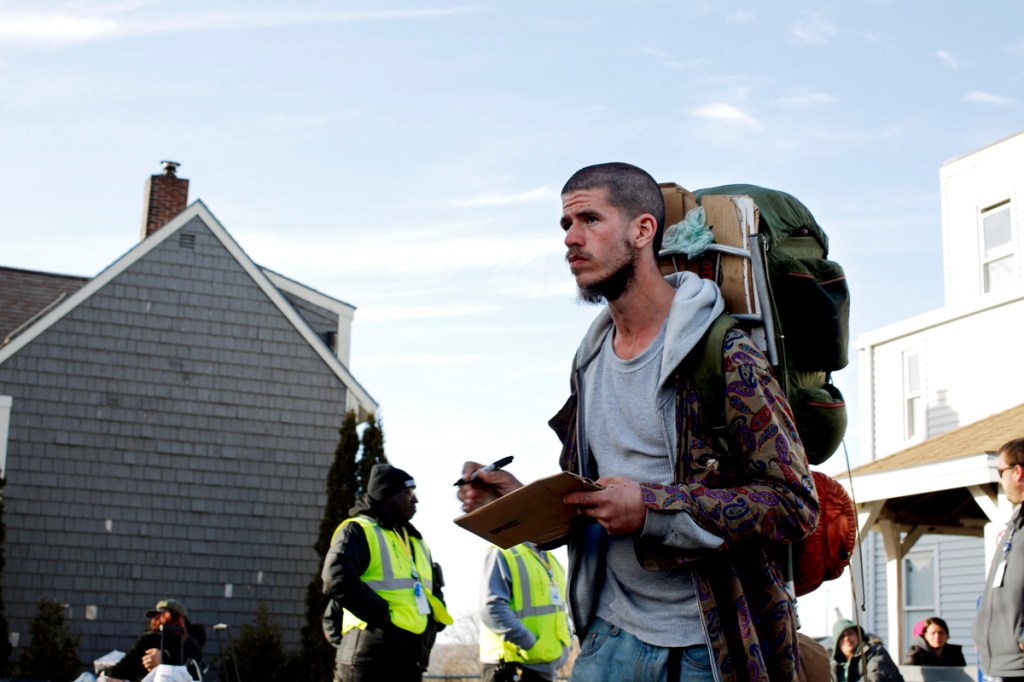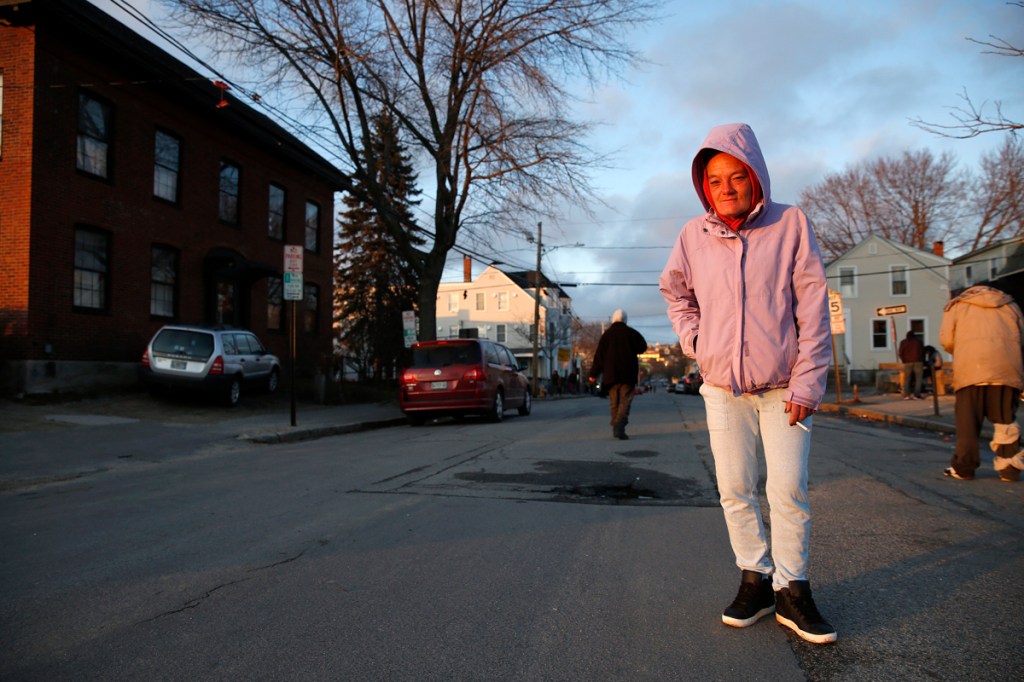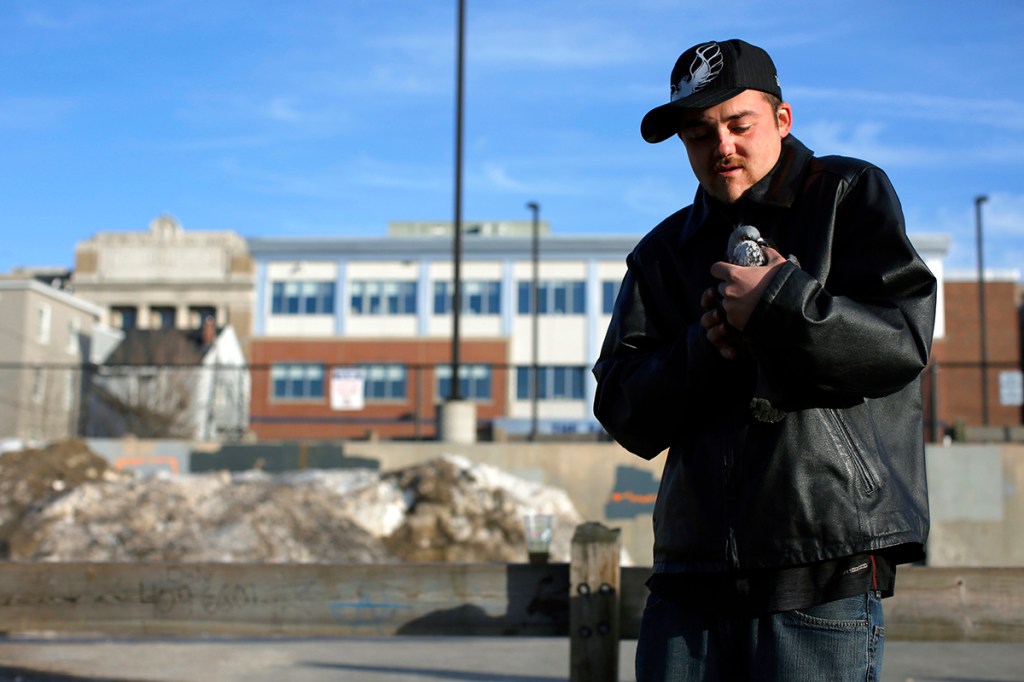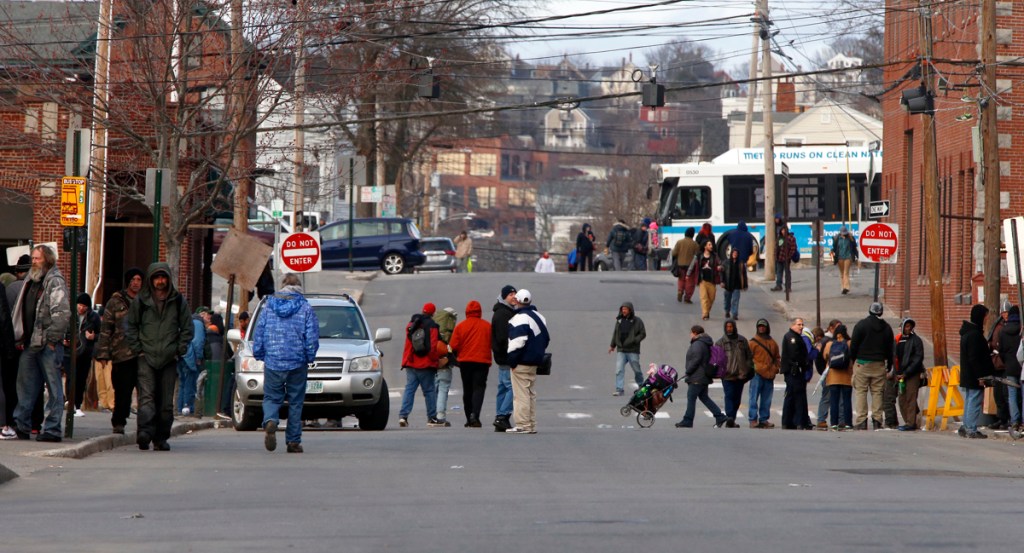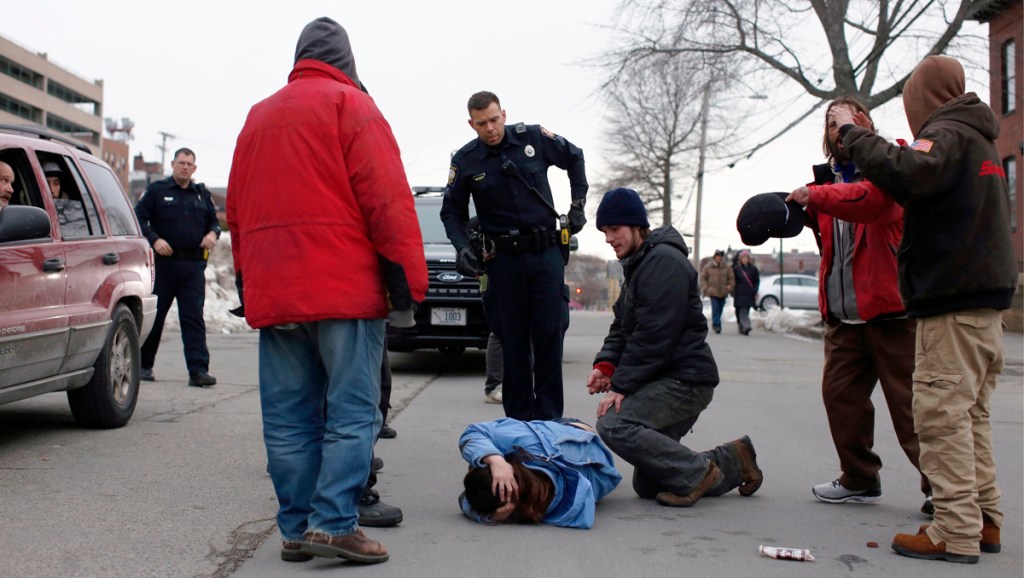Rough-looking crowds gather on street corners. Alcoholics drink openly on public sidewalks and addicts slide needles into their arms and legs. Others in drug-induced stupors slump over in doorways and entryways. Some slip into alleyways and private driveways to relieve themselves or engage in sexual acts. And tempers flare, leading to arguments and fights on city streets.
It’s springtime in Portland’s Bayside neighborhood. As the leaves and grass begin to grow, so too will the throngs of desperate, vulnerable people drawn to this area just two blocks from City Hall by the city’s overnight shelter on Oxford Street and an array of services just two blocks away at Preble Street.

After decades of coexisting with this population and the service providers who try to help them, many Bayside residents say they’ve had enough. They’re pressuring the city to do something, and they’re raising questions about the activities and impact of Preble Street, which serves about 400 people a day at its resource center.
In response to that pressure and mounting interest from real estate developers seeking to invest in the neighborhood, the city is planning to revamp and relocate its homeless shelter from Oxford Street to another part of Portland – an effort that could take years to come to fruition, if it does at all.
And Preble Street, one of the city’s most venerable and influential social services agencies, stands at a crossroads. It faces decisions about whether to follow the shelter and whether to change the way it serves the needy people who flock to its services in ever-growing numbers.
“I don’t know what’s going to be in the future for Preble Street,” Executive Director Mark Swann said, noting the agency’s unpredictable evolution. “But I am concerned, for sure, about the state of the human service system, or a lack thereof.”
Preble Street began more than 40 years ago, as a little experiment conducted by a gravel-voiced, heart-on-his-sleeve college professor from New York looking to give his students hands-on experience navigating a shrinking, yet increasingly complex, maze of social services for a growing number of vulnerable people in Maine’s largest city.
But in the last 15 years, the nonprofit has grown from having a $1.5 million budget, a handful of programs and a few dozen employees to a $12 million agency, over a dozen programs serving more than 5,000 people a year, and more than 200 part- and full-time employees, according to a Maine Sunday Telegram analysis of tax documents filed with the Internal Revenue Service.
Preble Street now sits among the top 2 percent of Maine nonprofits in terms of spending. And the rapidly evolving Portland nonprofit provides services well beyond Portland’s borders.
‘NOW I FEEL VIOLATED’
Homelessness and the predatory behavior it attracts, such as drug dealing and human trafficking, is approaching a breaking point in Bayside. Street behavior is becoming increasingly aggressive, erratic and defiant, according to the city’s shelter director and accounts from more than a dozen residents.

A man who declined to speak with the photographer teeters unsteadily on his feet in the middle of the street near Oxford Street Shelter. The pose is often associated with users of “spice” – a synthetic drug that resembles marijuana but smells like burning plastic when smoked.
Although they sympathize with those in need, neighborhood residents are increasingly unnerved by people on “spice,” a potent and addictive form of synthetic marijuana, whose chemical composition is constantly changing, making it dangerous and virtually impossible to outlaw.
Residents say that, during the summer months, the streets between Preble Street and the Oxford Street Shelter can become impassable because large groups of unruly people clog the roads and gather on the sidewalks.
Gone are the days when staff could leverage an overnight mat to get someone to stop drinking in public, said Rob Parritt, director of the city’s Oxford Street Shelter. There’s been a shift toward people on harder drugs who don’t care about staying at the shelter. And it’s not unusual, he said, for people to be discharged to the shelter from jails or hospitals.
“I used to know every guest that stayed with us on a first-name basis,” Parritt said. “We’re just seeing a lot of folks we don’t know.”
‘The influx of active drug addicts/alcoholics and their inappropriate behavior have made it very difficult to do business and live in Bayside. Every year is getting more out of control and I fear the worst.’
— Dennis Ferrante, resident/business owner
Sarah Michniewicz, president of the Bayside Neighborhood Association, said she had a breakdown last summer. She has lived on Cedar Street near the city shelter for 20 years and, until a few years ago, never felt threatened. Now she’s concerned not only about the quality of life in her neighborhood but also about the self-harming behavior she regularly sees.
“It used to feel like it was a coexistence, but now I feel violated,” she said. “I can’t walk into my backyard without wondering what I will find.”
To drive home the impacts of what occurs in the neighborhood every day, Michniewicz compiled testimonials from 10 Bayside residents for a report she gave city councilors when they toured the area last fall.
The report contains graphic images captured by cellphones and home surveillance cameras.
“They are ugly and some are shocking,” she wrote about her own series of photos. “Bear in mind that none of us get such a warning before encountering them in real life.”

Bayside resident Sarah Michniewicz secures her Cedar Street home with cameras and motion-activated lights. Michniewicz’s property has been the site of public fornication and drug use. “It used to feel like it was a coexistence, but now I feel violated,” she said.
There’s a photo of a young man, just below her kitchen window, plunging a needle into his heavily tattooed forearm in broad daylight. Another of a young man who followed her to her door. She later discovered he had a criminal history for burglary.
A particularly graphic daytime photo shows a man and woman having sex, braced against the side of a parked pickup truck. Michniewicz said they just smiled at the neighbor who tried to shoo them away.
There are other daytime photos from other residents of people defecating on public and private property. Suspected daytime drug deals on highly visible street corners. People laid-out on sidewalks and entryways. And needles dotting the perimeters of people’s homes.
On a recent morning, James Osbourn arrived at a vacant house on Cedar Street with a paper bowl full of Froot Loops and milk, eating them with a plastic spoon. Already waiting for him was a man calling himself “Trick,” who planned to trade his cellphone for heroin so the pair could get high in a nearby basement – a hot spot where the lock has been broken by other addicts.

“Trick,” left, and friend James Osbourn check a syringe full of heroin in the laundry room of a Cedar Street apartment building. The room is a hot spot for heroin users, many of whom do not live in the building.
Osbourn described the immediate area around the Preble Street Resource Center and the city’s Oxford Street Shelter as a safe zone for drug users.
“You can get high down here without anyone giving you a hard time,” he said.
Minutes later, the 47-year-old Trick scored a quarter-gram in an open-air deal outside the resource center’s soup kitchen, where a busy dealer made two similar transactions in rapid succession.
“This is the only neighborhood that we have – that we’re welcome in,” Trick said. “Can you imagine if we tried this on the other side – in the Old Port?”
Last summer, a longtime business, Maria’s Ristorante, whose parking lot is across from the Resource Center, announced it was leaving its location of over 40 years, citing the rise of indecent conduct near the resource center. For now, the restaurant remains open at its Cumberland Avenue location. Its owners declined repeated requests for an interview.
And city officials held a forum with downtown business owners and residents last August after the owner of Sisters Gourmet Deli in Monument Square posted a surveillance video of a disturbed man screaming obscenities at her employees.
PREDATORY BEHAVIOR
Issues in Bayside are like those in other urban communities that struggle to address the root causes of homelessness: broken mental health systems; high health care costs; an opioid epidemic with few treatment options and fewer options to pay; a lack of affordable, work-force and supportive housing; and low and stagnant wages that are not keeping pace with the cost of living.
All while the social safety net is being deliberately unwoven.
City Councilor Belinda Ray, who represents Bayside, sympathizes with residents. She says they are understandably frustrated by a lack of progress on the larger societal issues that are producing the obscene scenes compiled by Michniewicz.
Social services were intentionally clustered in Bayside with the best intentions, she said.
The plan was to weave together a tight network of low-barrier services for people in need, giving them access to soup kitchens, the Preble Street Resource Center and the city’s overnight emergency shelter without having to fill out a lot of paperwork, show identification, agree to work on a housing plan or be sober. It’s intended to be an entry point for an array of social services – one based on relationships and trust, which can begin simply by giving someone a new pair of socks.
But important services to treat mental illness and substance abuse, coupled with a lack of low-income housing, are becoming increasingly rare, forcing many to remain in limbo at Preble Street awaiting help that may never arrive.
“People are asking for help and we have nothing for them – that’s what’s so sad about this work,” Swann said. “So they continue on the street. They stay in the shelters. They don’t get the help they need.”
Ray said the crowd of desperate, damaged people has created a large pool of potential victims for predators.
“The vulnerable population isn’t the problem,” said Ray, who continues to support a low-barrier system. “It’s what springs out of that. We often get predatory behaviors around vulnerable populations. So you have people who are human traffickers and drug traffickers who are trying to get those checks that come out at the beginning of the month from people.”
Ironically, the increasingly hostile environment that has grown up around the cluster of low-barrier services is becoming a barrier for others in need.
Katie Farr said she and her wife, Trish, who is from Portland, ended up at Preble Street last summer after becoming unemployed and without a place to live. The 36-year-old Navy veteran said she’s traveled around the world and has never seen – or experienced – anything like the summertime crowds gathered outside of Preble Street.
Farr said some of those people encouraged her to prostitute herself, rather than panhandling, to make money. Others were openly using drugs on the sidewalks. Instead of prostitution, Farr and her wife joined the city’s Portland Opportunity Crew, which offers work to panhandlers. And they got regular jobs and an apartment in Biddeford.
“I was in the Navy. I’ve been all over the world. I’ve been in more countries than states. But I think coming down here was the biggest culture shock of my life, compared to anywhere,” Farr said. “I pretty much cried for the whole first week we were here and didn’t talk to anybody.”
‘A LITTLE EXPERIMENT’
Three years after moving from New York to Portland in 1972, Joseph Kreisler planted the seed for the agency that would become Preble Street.
From an early age until he died in 2002 at the age of 82, Kreisler was an activist. At 14, he picketed outside his father’s soda factory in Yonkers, holding a sign reading “My Father Unfair to Organized Labor” over a $1.75 debt he felt he was owed.
After becoming the head of the University of Southern Maine’s social work program, Kreisler opened a low-barrier resource center at 68 High St., which he once called “a little experiment.”
Initially funded through a $1,500 grant, the center exposed about 20 students to the challenges of social work and had no paid staff.
Training students continues to be a part of the group’s mission, but under Swann’s leadership, Preble Street’s presence – both in Bayside and statewide – has grown significantly. Much of that growth has been a reaction to the loss of other shelters and community services, as funding for a social safety net has dried up.

A crowd gathers at the intersection of Preble and Oxford streets where two men are fighting in the street adjacent to Preble Street Resource Center.
Today, the resource center, which in 2015 had a $1.4 million budget and saw about 400 people a day, employs about a dozen caseworkers, each of whom is responsible for working with about 28 people on housing and self-improvement plans.
But staff must also maintain order at the center, which is a social setting for people otherwise shunned from the business district. It’s become a place where the outcast and downtrodden can play a game of cards, roll a pile of cigarettes using bulk tobacco or maybe just read a book. Some simply wait for help in the form of housing and other services that may never arrive.
“The changes over the last 25 years have just put more and more pressure on that building – far beyond our wildest imaginations,” Swann said. “We were not founded as a shelter, or a homeless organization or a soup kitchen.”
TENT CITY AT CITY HALL PLAZA
One of Preble Street’s first political actions occurred in 1987, when it joined a coalition protesting the lack of emergency shelter in Portland. About 100 people, including many homeless, set up a “Tent City” encampment at City Hall plaza and later at Lincoln Park, with a goal of getting the city to provide low-barrier shelter and services for anyone in need.
Despite concerns that Portland would become a regional magnet for homelessness, then-City Manager Robert Ganley agreed to the group’s demands after two weeks.
“He really established a norm and a policy and a value to this community right then that we think is still the right thing to do and as far as we’re concerned it’s still a policy of the city,” Swann said in a video celebrating Preble Street’s 40th anniversary.
The city eventually created the Oxford Street Shelter. Originally a 20-bed, low-barrier facility, it has been expanded to accommodate 154 people on thin mats only inches from each other. The city also runs a family shelter on Chestnut Street.
In recent years, at least two-thirds of the people seeking emergency shelter at both facilities have come from other Maine communities, out of state and out of country. The shelters regularly exceed capacity, forcing officials to find overflow space at Preble Street, the Salvation Army gym and in some cases the city’s own General Assistance office.
Tom Blackburn, who has lived on Hanover Street for 20 years and served on a task force on homelessness in 2011, has advocated for Preble Street to tighten up its low-barrier policies.
“Portland is a very compassionate city and wanted to take care of these folks,” the 69-year-old Blackburn said. “Unfortunately, what happened was that became an open invitation.”

Oxford Street Shelter director Rob Parritt poses for a portrait within the shelter’s second-floor women’s dorm. The shelter has seen an increase in people using harder drugs and an increase in homelessness. “I used to know every guest that stayed with us on a first name basis,” Parritt said. “We’re just seeing a lot of folks we don’t know.”
Ron Spinella, 68, who has lived in Bayside for more than 20 years, believes that Preble Street makes it easier for other communities to avoid taking care of their own residents.
Swann said many urban communities believe they’re magnets for homeless people from other communities, but poor people migrate to where they have the best chance to survive.
“It is an absolute prevalent notion across the country that our city is somehow taking on the poorest of the poor from everywhere,” he said.
RIGORS OF THE OPIOID CRISIS
The pressing needs at the resource center are overwhelming Preble Street staff. In some ways, they have become first responders in the ongoing opioid epidemic, which first presented itself at the center four years ago.
In 2017, staff responded to an overdose once every eight days and saved 40 lives, Swann said in testimony prepared for a statewide bill to address opioid use among homeless populations.
“For four decades Preble Street has trained social workers in building relationships, in helping people find housing, and jobs, and reunite with their families,” he wrote. “Now the very first thing we train social workers to do is reverse an opioid overdose. Every staffer carries naloxone and is trained in how to administer it.”
Staff have now developed formal procedures for responding to overdoses, including maintaining calm in a crowded room of people who are easily triggered into crisis.
Motion-detector lights were installed in restrooms, and the bottoms of bathroom doors were removed – all so staff could more quickly detect and respond to overdoses.
Since last summer, the center began closing early on Wednesdays so staff can decompress, train and work through the stresses of the job, according to Casework Services Supervisor Mary Beth Sullivan.
“When we open a bathroom door and find a client who has turned blue, it’s an emotional experience,” Sullivan said. “We meet as a team every week … to debrief and create space for healing after these critical incidents. This time allows us to develop protocols for new challenges, and identify what we need to do to care for ourselves and each other so we can continue to respond effectively.”
HEAVY POLICE PRESENCE
City officials have been trying to turn the tide in Bayside.
In 2016, the city launched Bayside Boost, which increased police foot patrols in the neighborhood, and focused on basic quality of life issues such as litter, garbage and street lighting. The initiative was launched a few months before the city put its former Public Works campus in Bayside on the market for redevelopment.
Last summer, the Oxford Street Shelter remained open during the day so people weren’t forced onto the streets. That helped ease some pressure at the resource center.
This spring the city plans to install outdoor restrooms and lockers at the shelter. And city staff act as security guards and patrol the neighborhood wearing bright safety vests.
“The city has done a fantastic job,” said Spinella, the Bayside resident of more than 20 years. “I know nobody wants to believe that.”

Portland police arrest a woman on Oxford Street, near Cedar Street, after she threw a can of beer at an officer, according to witnesses. Her male companion had been arrested moments earlier on a charge of trespassing at the Oxford Street Shelter.
In a written budget request last April to increase staffing, Police Chief Michael Sauschuck said calls for service in Bayside have increased by 71 percent over the last decade, even though it accounts for only 1 percent of the city’s landmass and 5 percent of its population. Service calls for the rest of the peninsula, he said, remained relatively flat.
That statistic shocked Jennifer Ackerman, an assistant district attorney for Cumberland County. She toured the neighborhood last summer with Ray and helped organize another tour with other attorneys and judges.
“I thought that was crazy,” Ackerman said. “One neighborhood was taking up so many resources from the police.”
She singled out the resource center’s low-barrier services as being an aggravating factor.
“The resource center needs to be a good neighbor and put some expectations on people’s behavior,” Ackerman said. “Otherwise, they will walk all over people in the neighborhood.”
Swann said the center does have rules. When they are not followed, people are banned from the center, but that only forces them into the neighborhood. And there is little the nonprofit can do once people leave the building, he said.
“There really is no role for us in that,” Swann said. “We’re not police officers. It’s a significant challenge.”
Bayside Boost, and changes at the city shelter, seem to be making a difference, according to Micheal Bachelder, who has lived on lower Hanover Street for the last 16 years. He thinks increased police attention to so-called hot spots, such as the corner of Hanover and Portland streets near Dyer’s Variety, is having the biggest impact.
Before Bayside Boost, it was not unusual to have 40 to 50 people hanging around at night, he said.
“The police and the city of Portland got together and said they had to do something,” the 67-year-old said. “They’ve been throwing people off that corner. It’s been getting better.”
But even when people are arrested, they are often back on the streets within a few days, where the same temptations await.
A NEW MODEL
The fate of Preble Street’s services in Bayside is inextricably linked to the city shelter. That’s why the nonprofit is beginning to rethink its existence in the neighborhood.
Last year the city changed its zoning to allow emergency shelters in more neighborhoods. Prior to that, shelters could only be located in Bayside.
City officials are now looking to build a more modern facility with about 200 beds to better accommodate clients and city staff. Officials are scouting locations outside of the neighborhood for a new shelter with expanded services, 24 hours a day.

A man sleeps in the doorway of 23 Portland St., a few doors down from the Preble Street Resource Center. The address is part of a block recently purchased by Maine-based T International Realty, which is eyeing redevelopment.
Based on best practices observed in other communities, city officials would like to include many of the services Preble Street provides, such as a soup kitchen, showers, laundry and wrap-around referral services for employment, housing, substance abuse treatment and mental illness. The goal is to give people the support they need to turn their lives around at one facility, rather than spreading those services out.
Swann said his board of directors is already discussing the potential impact on the nonprofit. He’s also in talks with the city about what role, if any, Preble Street could fill at a new shelter, estimated to cost $10 million or more. Swann pointed to the nonprofit’s well-established network of food providers, volunteers and donors.
“We’ve talked to the city about our interest in playing a supportive role in that sense,” Swann said. “Neither party wants to duplicate services. Both parties want to do the right thing. And neither party has a lot of resources.”
In 2014, Preble Street’s nearly 6,000 volunteers served close to 400,000 meals over three courses at the soup kitchen. That year, the resource center furnished about 6,450 loads of laundry and 12,555 showers, according to agency records.
Ray, the city councilor who chairs the Health and Human Services Committee, which is overseeing the city’s shelter relocation project, joined city staff and other councilors on a tour of homeless shelters in Massachusetts in 2016 to explore alternative models. She hopes the city will have a site selected by the end of the year so the planning effort can move forward.
“I always say our staff is so amazing. They help so many people. But the facility we have given them to do this in is not adequate and it does not allow them to put the best practices in place,” Ray said. “That’s why we need a new facility that will offer 24-hour shelter and services on site.”
DEVELOPMENT PRESSURE
For some longtime residents and real estate speculators, a new shelter system outside of Bayside cannot come soon enough.
Such a move would likely transform a neighborhood that’s only a block from Monument Square and has some of the only undeveloped land on the peninsula. This would come at a time when market-rate housing and mixed-used developments are occurring at a pace rivaled only by the rebuilding efforts after the Great Fire of 1866.
‘My concern is for the children I serve. Children who are exposed to violent and alarming acts repeatedly may experience increased anxiety, fear and helplessness. This is especially true for children who may have a trauma history.’
— Karen Hunter, social worker at the Bayside Learning Community
Josh Soley is the point man for T International Realty LLC, a group of anonymous investors that recently bought buildings abutting the resource center at 5 Portland St. He said they are “looking to buy everything possible in the area,” including the center, even though Swann says it is not for sale.
The 23-year-old grandson of Joe Soley, who bought blocks of buildings in the Old Port before it became a tourist destination, Josh Soley believes the culture that has grown up around Preble Street is holding the neighborhood back.
“It’s been an eyesore on this entire peninsula,” he said. “And I think with the future movement of the facilities down here – the soup kitchen and the Oxford Street shelter – this area is going to be the future of Portland real estate.”
Meanwhile, one block west of the resource center, the city has been selling off parcels that once comprised its 4-acre public works complex in Bayside.
One project, 23 units of workforce housing by Soley’s uncle, Jack Soley, has already been approved by the Planning Board. And the Szanton Co. recently held a community meeting ahead of submitting plans for a 46-unit apartment building for people ages 55 and older at 178 Kennebec St.
Development activity will inevitably reach Bayside, regardless of whether Preble Street moves, said Paul Peck, president of the Maine Real Estate and Development Association, a trade group of building professionals.
Peck pointed to the addition of 55 units of housing, known as 117 Lofts, in the former Schlotterbeck & Foss building on Preble Street, and the expansion of Bayside Bowl.
That pales in comparison to the hundreds of new housing units on dozens of properties that have been built from the West End and East End in recent years, where new office buildings and hotels are also being planned and built.
Nevertheless, property values in Bayside have continued to increase, despite the neighborhood’s challenges, Peck said.
“There’s a lot of pressure around the city for development and there aren’t a lot of areas left,” he said. “Sometimes areas take longer to develop. Obviously, the resource center and the shelter have an influence down there, and they do great work. But there are (other) impediments to doing development downtown. I think development is going to come either way.”
Swann said he fully supports the city’s exploration of a 24/7 emergency shelter, which could allow Preble Street to refocus its mission at the resource center. For now, he’s waiting for the city to choose a site and finalize a plan – a process that will likely take years.
“The challenge is kind of the waiting, the uncertainty and the extraordinary politics that is going to play out as this progresses,” Swann said. “There’s absolutely an opportunity to rethink what we do at the resource center, how we do it and for whom.”
Staff Photographer Ben McCanna contributed to this report.
Send questions/comments to the editors.


